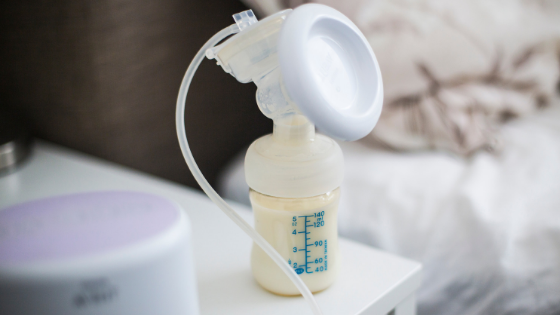What You Need to Know About Pumping for Your Preemie
Giving birth earlier than expected is very stressful, and often scary. Depending on your baby’s gestational age, they may have an extended NICU stay, be hooked up to lots of noise-making machines, and have occasional health setbacks that make your heart leap into your throat. You may not be able to do much more than talk to your baby at first, which is really hard when all you want to do is gather them up and go home.
But there is something that you can do to truly “feel like a real parent” to your premature baby.
Something only you and nobody else can provide specially for them.
Your pumped breastmilk!
Your baby may not yet be developed enough to breastfeed, but your colostrum and milk will help them grow, fight off infections, and meet their NICU milestones. Even if you don’t plan to breastfeed or haven’t made that decision yet, you can at least provide pumped colostrum during the NICU stay when survival is critical. Here are some things you must know about pumping for a premature baby!
Making Pumping for Your Preemie a Good Experience
Pumping is not fun or convenient. It is definitely work, and a beautiful sacrifice - but there are some things that you can do to make it a better experience for yourself, or at least eliminate any associated pain or discomfort. Find out if there is a special pumping room where you can go for privacy and comfort when you are just getting used to pumping. After the first several days, you will become a pro and may feel totally comfortable pumping by your baby’s bedside.
Make sure that your pump flanges are the correct size (if you have large breasts, the standard size flanges that come in the breast pump box are not likely to be large enough for your whole areola to be sucked inside the tube portion), and lubricate the tubes with a drop of your milk or nipple ointment to avoid discomfort.
If you aren’t able to look at and talk to your baby during the pumping session, look at a video of her on your phone and sniff one of her little blankies. This will help stimulate your body’s milk letdown reflex, which is normally triggered by breastfeeding.
Avoid getting painful and/or infected clogged milk ducts in your breasts by pumping frequently, not letting your breasts stay hard and engorged too long. You can also use warm compresses on them, or massage them downward toward the nipple while pumping.
2. Deciding How Long and How Often to Pump
Depending on your ability to tolerate the pump, and how easily your milk flows, you may find that ten, fifteen, or even twenty minutes per pumping session works well for you. Pumping an extra couple minutes after the milk ceases to flow will stimulate your milk production to ensure a good supply. You should go for shorter and more frequent sessions rather than trying to grit your teeth through an extra long one, which will likely only cause pain.
When trying to come up with a pumping schedule, you should consider mimicking the typical schedule of newborn feedings. You will probably want to pump every two to three hours during the day, and every four to five hours during the night. A few weeks of this schedule will greatly increase your abilities to provide a steady milk supply once your baby is able to feed directly from the breast.
You can and should definitely consult the lactation specialists at the hospital for your specific situation.
3. How Will the Baby Receive the Pumped Breastmilk?
How your baby receives their feedings is all up to their age and stage of development. A very tiny premature baby up to 28 weeks’ gestation may still be receiving IV nutrition until their stomach is mature enough to handle milk. Once the stomach can process milk, they can graduate to being tube fed directly into the stomach. You can help ensure that your baby’s very first real feeding is of your colostrum!
Once your baby is developed enough to coordinate the simultaneous actions of sucking, swallowing, and breathing (usually at about 32 to 34 weeks’ gestation), they can be fed your milk via a small silicone cup. This cup is messy and you will have to be okay with the fact that some of your milk will get spilled - but even the small amount of milk that will be swallowed by your baby will provide wonderful nutrients and comfort.
4. What Will the Milk Be Like?
If this is your first time expressing breastmilk, you may wonder what it will be like. Colostrum, or the very first milk, is often called liquid gold - not just because of how valuable it is in terms of antibodies and nutrients, but also because of its thick, yellowish appearance. For your first few days, you may only pump out a few drops or teaspoons of this powerful substance. Do not be alarmed by the small amount - it is normal. Continue to pump and collect each drop. Once your milk “comes in”, which typically happens 2-5 days after birth, you will notice that the appearance starts to look thinner and whiter, like the “regular” milk you are used to seeing. You will also see a larger volume, perhaps being able to pump up to an ounce or more per session. You might also notice that the cream rises to the top after the bottle has been sitting undisturbed after a while.
Depending on your baby’s overall health status, the neonatologist may recommend mixing some human milk fortifier into your pumped breastmilk before giving it to your baby. Please do not get discouraged or think that your milk is not “good enough” - some premature babies simply need to have extra calories packed into every feeding in order to thrive.
5. Safe Breastmilk Storage and Handling for a Preemie
Although cleanliness and food safety is always important, when it comes to a premature baby you do not want to take any unnecessary risks when it comes to sanitation. Always have freshly clean, scrubbed hands when pumping for your preemie and handling the milk. We really like and recommend the Kiinde Twist breastmilk storage system, because you can pump directly into the milk storage bags and decrease the amount of handling and possible contamination. You can ask your baby’s doctor or nurses if they specifically recommend one type of milk storage for your baby’s use, though.
While we love “mom hacks” like the fact that pumped breastmilk can be at room temperature at ten hours and still usable; or refrigerating the pump parts instead of sterilizing them after each use. However, with a premature baby, we do not recommend cutting corners.
Ideally, you will pump before the feeding times and give your baby the milk while it is fresh and warm from your body. If the milk will be used within 1-2 days, store it immediately in the refrigerator. If it may be longer before the milk from that pumping session will be used, you should store it in the freezer.
To thaw your frozen breastmilk, place the bag or bottle into a clean and sanitized container of water. This is a quick, effective, and safe way of thawing breastmilk. Never use a microwave, as they can cause unexpected hot spots.
Pumping for your premature baby is the first gift you will ever give them, and it is a long-lasting one. It’s not glamorous, but you will feel good about parenting your child in this way even though they are yet medically fragile. And before you know it, they will be strong and healthy enough to put to your breast…and one day soon, come home with you to share your life.

